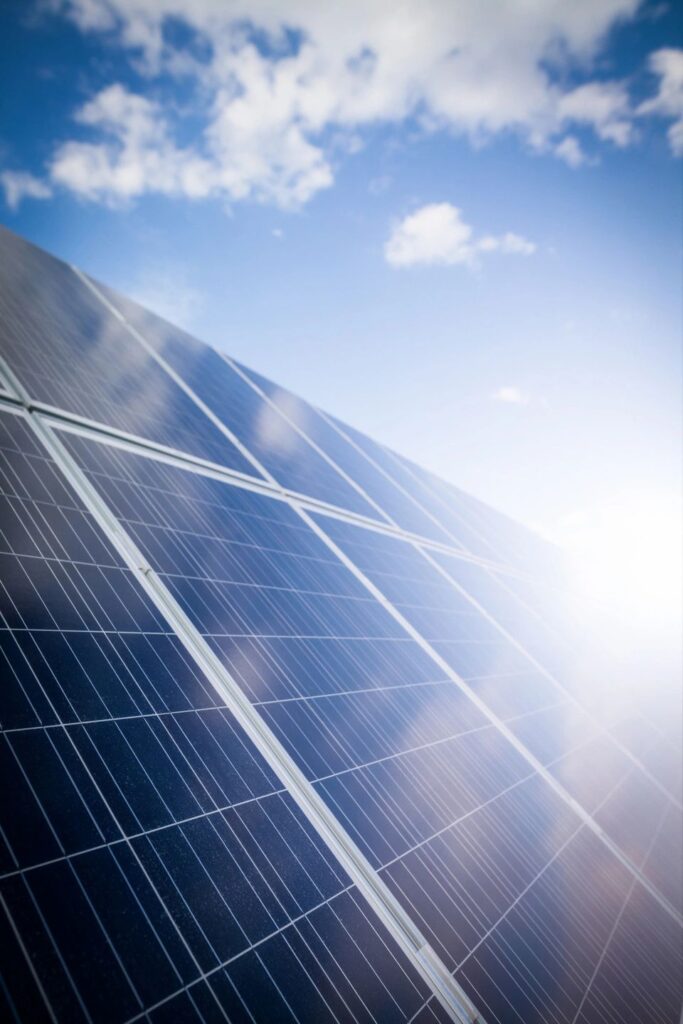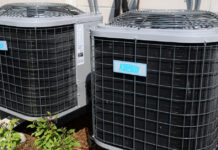Our Solar Power Journey, Part 3
In this section of our solar power coverage, which is part three in the series, we address the inverter. For information on panels and batteries, see part two, or start at the beginning with part one.
We tend to think of the solar panels when we think of solar power, but the inverter is really the heart and the brain of any solar system. The inverter does the hard work, including:
- Uses the DC current from the solar panels to charge your batteries, converting the voltage as necessary, thereby storing the solar power for future use.
- Turns the DC current from the panels into AC current used by your home’s electrical system.
- Sends excess AC power out to the grid, if you are in a grid-attached system.
- Converts DC power stored in the batteries to AC and distributes it throughout your home. For off grid systems, this happens whenever you flip a switch.
- Accepts power from your generator and uses it to charge your batteries.
- Monitors the health of your batteries and optimizes their charge.
Types of Inverters
There are multiple types of inverters available, mostly matching they types of systems. Whatever kind of inverter we get, we want one with a MPPT controller, which does the best job of converting power from the panels into usable electricity with minimal loss. We also want a pure sinewave inverter as they are the safest for use with computers, TVs and other electronics. Modified sine inverters can cause pumps and motors to fail prematurely. Since there won’t be refrigerator repairmen in a post-TEOTWAWKI world, we don’t want to cause any of our appliances to fail early.
String Inverters
String inverters get their name because you connect a string of solar panels to them. The better models allow you to connect multiple strings, so if you have one set of panels facing West and another South, you would plug them in separately. This also allows space for a hydropower of wind-powered generator.
String inverters are the most common, lowest cost, and simplest to install.
Off-grid inverters are a good example of sting inverters. These are what you would use in an off-grid solar system. They do no interface with the grid and cannot sell power back to the utility, but they handle all the other aspects of the job, from charging your batteries to running your house. The better models offer multiple MPPT (maximum power point tracking), whicih allows you to accept power from multiple sources, storing it in your battery bank, and powering your household electrical system. This is what we often call the standard or traditional inverter because they have been around the longest.
Hybrid inverters, as you might have guessed, are string inverters designed for grid-interactive solar power installations, as we discussed in part two of this series. The do everything off-grid inverters do, plus interact with the grid.
Some of these systems will allow you to use battery power when the utilities are charging you the most per kilowatt, and then recharge the batteries when the cost is lower.

Micro-Inverters
Relatively new are something called micro-inverters. While regular inverters are large boxes mounted on a wall near your electric distribution box, micro-inverters are mounted on the panel. In fact, you need one per panel, so if you have 24 panels, you need 24 inverters. (Although I’d get 25 to have a spare.)
The beauty of micro-inverters is that they maximize the performance of every solar panel. If you have a few panels in the shade, this will not affect the amount of power produced by other panels, which is not always the case with traditional inverters. Also, if one inverter goes down, you don’t lose all your power, just the power from that panel.
While there is no such thing as an inexpensive inverter, the cost of microverters is higher than the average stand-alone inverter because you need so many of them plus a central box that brings together all that power and handles the switching between your house and the grid.
The biggest downside is that all these micro-inverters do is converts DC power generated by the panel to AC power to be used in your house or sold back to the utility. They do not charge your batteries. As a result, most micro-inverters are used in grid tied systems that sell electricity back to the utility and are not appropriate for off grid or hybrid solar power systems. In fact, most of them don’t even operate when the grid is down.
Although some microinverter systems are starting to offer battery backup, like most popular “power wall” products, they require Internet access to function. Clearly, these won’t work for us or for most preppers.
Optimized Sting Inverters
Optmised String Inverters combine the benefits of string inverters with a power optimizer that attaches to the back of each panel. Unlike the micro-inverters, these do not convert the power from DC to AC, but they do handle the MPPT work, which allows the main box to be a bit smaller. They also offer the advantage of being able to monitor the performance of individual panels.
Cost, Power and Other Considerations
Because the inverter is the heart of the system, they are not cheap. But the larger they are, the more cost effective. For example, a string inverter rated at 3,800 watts might cost $1,300 while one rated for twice as many, 7,600 watts, might cost $1,950. In other words, you are getting twice the power at only a 50 percent increase in cost.
But you can’t just look at the cost of the inverter in its box. You have to ask what accessories it needs and calculate their costs. Does it include any cables? Do you have to buy any extra modules? Can you install it yourself or do you need a local electrician or solar installation company to qualify for the warranty?
Some inverters will work with an app and to be plugged into a communications module or WiFi network. If the communications module works on a cellular signal, what will happen if you don’t have a cell signal? Do you have WiFi? Do you expect to have WiFi at the end of the world? Remember, as preppers, we want our inverters to work when they are cut off from the rest of the world.
What happens if you buy a 4 kW inverter and later add more panels? Can you link or string together two or more inverters? OR are you better off buying a larger model now, just in case.
How long is the warranty and what does it cover? Will they send someone out to you to fix it? Is there any kind of a remote diagnoses system available? How modular is the design? Is it user serviceable and can you stock any spare parts?
These are all questions worth considering.
Our Plan – so Far
If I had to make a decision today, we would go with grid-interactive system and:
- A Lithium battery bank, probably 24 volts with 5 to 10kW of storage.
- A 5kW string inverter or possibly an optimized string inverter. We have to evaluate brands, performance and cost more thoroughly before we can make a decision
- Somewhere between four and eight 300 watt solar panels, with the option to expand in the future to as many as 16.
This will let us test the whole concept of selling electricity back to the utility and determine if it really lowers our electric bill. We will also be able to assess how quickly an investment in additional solar panels will be “paid off,” if ever.
This set up will also allow us to test things out how much power is actually generated based on our location, our weather, and our equipment. We can then turn off the grid power and run some tests to see how well we manage living off grid with this limited capacity.

Let’s assume we have panels that during peak hours of full sun generate 1,800 watts of power. Is that enough to fully charge the batteries in a single sunny day? If so, how long does a fully charged battery system last? How many watts will they generate on a cloudy day? Will it generate any power in the fog?
Once the batteries are fully charged, will the inverter support our day-to-day living (minus using the stovetop, oven, heat pump, dryer and hot water heater)? What is the impact if we use the Keurig to brew a cup of coffee or the microwave to warm something up? Or ripping a few boards with the table saw? What about watching TV or using the desk top computer for an hour or two?
Based on this initial experience, we can determine how many more batteries are needed. We can then increase our storage capacity as necessary. (Another great thing about lithium batteries is that you can add more batteries as you go. This isn’t always possible with lead acid batteries because you want all the batteries in the system to be the same age.)
Once we get what we believe is our optimally sized battery pack, we can determine how many more solar panels we need. My guess is that we will end up at least doubling our batteries and tripling our panels. But by doing this in stages, we can spread out our investment so all that money doesn’t drain out of our pockets all at once.
The Role of a Generator
Many people with off-grid solar systems rely on a generator to recharge the batteries when they get low and the sun is not shining or when they need to consume large amounts of electricity, like running a large number of power tools.
In a traditional off-grid living scenario, when you can hop in your car, drive to town and buy more gasoline, diesel or propane, this makes perfect sense. You can then follow the 80-20 rule and scale your solar system to meet your needs 80 percent of the time and run your generator when it has been snowing for three days in a row and your batteries are low.
But if we are preparing for the end of the world as we know it, we have to assume that replenishing traditional fuels will be impossible or nearly so. That means a generator is of questionable value long term. How to allocate finite fuel resources is a big enough subject for to warrant a separate article, but I am not sure running the generator is at the top of the list unless you need power for a medical or similar emergency where power was essential to our survival.
Our objective is to live on the solar power stored in the batteries day-to-day, run our high-draw appliances only when the sun is shining and the system is producing well, and fall back on small devices with rechargeable batteries if the system runs low.
How Many Days Without Sun?
How long will the system operate when the sun doesn’t shine? Given the vagaries of weather and seasonal differences, this will vary from winter to summer. If we are suddenly forced into an off-grid lifestyle by some SHTF event, will we be able to modify our consumption so we use electricity on sunny days and conserve on cloudy ones? What other lifestyle modifications will we need?
For example, my wife likes to do laundry every Monday. If we are relying on solar power, we may need to be flexible and do laundry on the first sunny day of the week, or we may have to spread it out with only one or two loads a day, depending on how much power it consumes. If the house is crowded with people who have bugged out, we may need to ration access to the washing machine.
Vacuuming also consumes a great deal of electricity. We may need to vacuum only on sunny days. Maybe we’ll learn that we cannot run the large Kitchen Aid mixer and the toaster oven.
We may also have to change our electricity consumption with the seasons because the panels will generate more power in the summer. Ideally, we would size the panels to provide sufficient power for the winter, but that will still give us “excess” power during the brighter, longer summer days.
Timing
Although rebates go down after the first of the year, I don’t see this installation starting in the next few months. I think spring of 2021 will be the earliest possible time frame. We have to sell our house to even begin to afford a solar installation, and I’d like to be in the house for a month or two to see what our normal electrical consumption is.
That means we’ll have more articles in this solar power series in the future, but probably not for a while.
Thanks for reading, and feel free to leave any comments or suggestions below.









